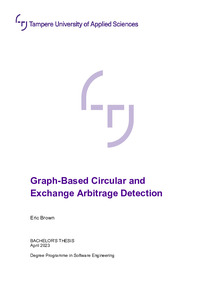Graph-based circular and exchange arbitrage detection
Brown, Eric Thomas (2023)
Brown, Eric Thomas
2023
All rights reserved. This publication is copyrighted. You may download, display and print it for Your own personal use. Commercial use is prohibited.
Julkaisun pysyvä osoite on
https://urn.fi/URN:NBN:fi:amk-202305098534
https://urn.fi/URN:NBN:fi:amk-202305098534
Tiivistelmä
Although (circular) arbitrage is already a well-known concept in the trading of crypto-currency pairs on decentralized exchanges (DEXes) like Uniswap, this thesis explored the idea of combining circular arbitrage with exchange arbitrage. The strategy was to leverage graph-theoretic methods on multiple DEXes and centralized exchanges (CEXes) that are aggregated and sorted by their offered exchange rates for each crypto trade pair. By doing so, the aim is to find a circular trade where each trade occurs on the DEX/CEX with the best rate, allowing for more profitable opportunities than being confined to one DEX for all trades.
This thesis not only explores the combination of circular arbitrage with exchange arbitrage but also focuses on the creation of a program that implements these strategies. Then the methodology used to develop the program and the arbitrage results obtained from its implementation are presented. In addition, this thesis explores other ways to optimize profitable
arbitrage opportunities and improve the program implementing this strategy. Examples include improving the speed and performance of the program, as well as maintaining profitable arbitrage even after accounting for the high gas fees required for each trade in the circular trade by factoring the ideal trade volume. Furthermore, other programmatic improvements are considered, such as changing programming languages and developing smart contracts with Solidity specifically for atomic transactions.
This thesis not only explores the combination of circular arbitrage with exchange arbitrage but also focuses on the creation of a program that implements these strategies. Then the methodology used to develop the program and the arbitrage results obtained from its implementation are presented. In addition, this thesis explores other ways to optimize profitable
arbitrage opportunities and improve the program implementing this strategy. Examples include improving the speed and performance of the program, as well as maintaining profitable arbitrage even after accounting for the high gas fees required for each trade in the circular trade by factoring the ideal trade volume. Furthermore, other programmatic improvements are considered, such as changing programming languages and developing smart contracts with Solidity specifically for atomic transactions.
